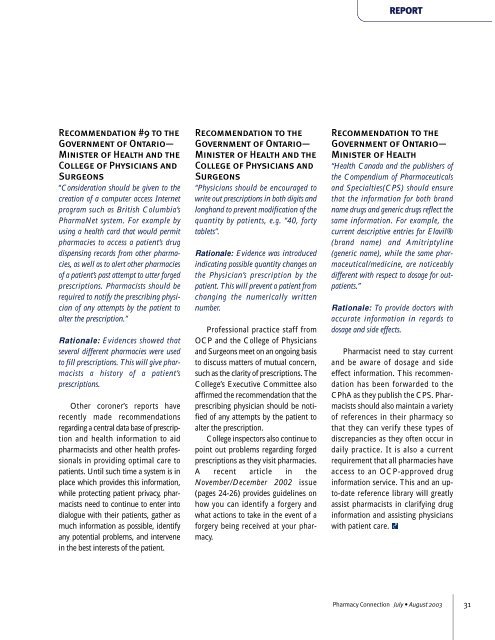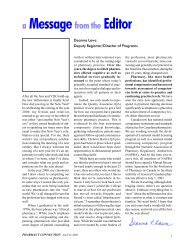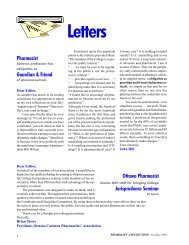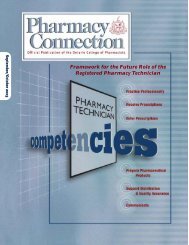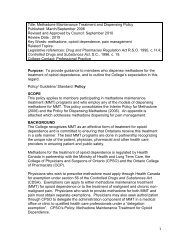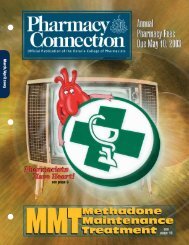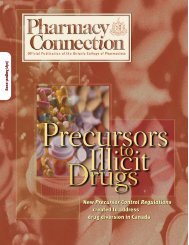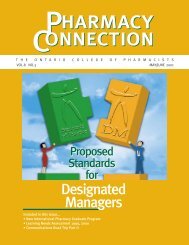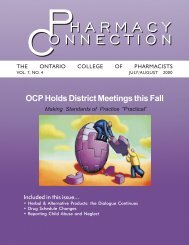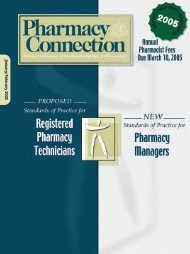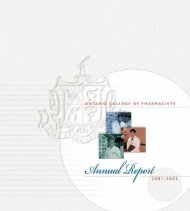July ⢠August 2003 - Ontario College of Pharmacists
July ⢠August 2003 - Ontario College of Pharmacists
July ⢠August 2003 - Ontario College of Pharmacists
You also want an ePaper? Increase the reach of your titles
YUMPU automatically turns print PDFs into web optimized ePapers that Google loves.
REPORT<br />
Recommendation #9 to the<br />
Government <strong>of</strong> <strong>Ontario</strong>—<br />
Minister <strong>of</strong> Health and the<br />
<strong>College</strong> <strong>of</strong> Physicians and<br />
Surgeons<br />
“Consideration should be given to the<br />
creation <strong>of</strong> a computer access Internet<br />
program such as British Columbia’s<br />
PharmaNet system. For example by<br />
using a health card that would permit<br />
pharmacies to access a patient’s drug<br />
dispensing records from other pharmacies,<br />
as well as to alert other pharmacies<br />
<strong>of</strong> a patient’s past attempt to utter forged<br />
prescriptions. <strong>Pharmacists</strong> should be<br />
required to notify the prescribing physician<br />
<strong>of</strong> any attempts by the patient to<br />
alter the prescription.”<br />
Rationale: Evidences showed that<br />
several different pharmacies were used<br />
to fill prescriptions. This will give pharmacists<br />
a history <strong>of</strong> a patient’s<br />
prescriptions.<br />
Other coroner’s reports have<br />
recently made recommendations<br />
regarding a central data base <strong>of</strong> prescription<br />
and health information to aid<br />
pharmacists and other health pr<strong>of</strong>essionals<br />
in providing optimal care to<br />
patients. Until such time a system is in<br />
place which provides this information,<br />
while protecting patient privacy, pharmacists<br />
need to continue to enter into<br />
dialogue with their patients, gather as<br />
much information as possible, identify<br />
any potential problems, and intervene<br />
in the best interests <strong>of</strong> the patient.<br />
Recommendation to the<br />
Government <strong>of</strong> <strong>Ontario</strong>—<br />
Minister <strong>of</strong> Health and the<br />
<strong>College</strong> <strong>of</strong> Physicians and<br />
Surgeons<br />
“Physicians should be encouraged to<br />
write out prescriptions in both digits and<br />
longhand to prevent modification <strong>of</strong> the<br />
quantity by patients, e.g. “40, forty<br />
tablets”.<br />
Rationale: Evidence was introduced<br />
indicating possible quantity changes on<br />
the Physician’s prescription by the<br />
patient. This will prevent a patient from<br />
changing the numerically written<br />
number.<br />
Pr<strong>of</strong>essional practice staff from<br />
OCP and the <strong>College</strong> <strong>of</strong> Physicians<br />
and Surgeons meet on an ongoing basis<br />
to discuss matters <strong>of</strong> mutual concern,<br />
such as the clarity <strong>of</strong> prescriptions. The<br />
<strong>College</strong>’s Executive Committee also<br />
affirmed the recommendation that the<br />
prescribing physician should be notified<br />
<strong>of</strong> any attempts by the patient to<br />
alter the prescription.<br />
<strong>College</strong> inspectors also continue to<br />
point out problems regarding forged<br />
prescriptions as they visit pharmacies.<br />
A recent article in the<br />
November/December 2002 issue<br />
(pages 24-26) provides guidelines on<br />
how you can identify a forgery and<br />
what actions to take in the event <strong>of</strong> a<br />
forgery being received at your pharmacy.<br />
Recommendation to the<br />
Government <strong>of</strong> <strong>Ontario</strong>—<br />
Minister <strong>of</strong> Health<br />
“Health Canada and the publishers <strong>of</strong><br />
the Compendium <strong>of</strong> Pharmaceuticals<br />
and Specialties(CPS) should ensure<br />
that the information for both brand<br />
name drugs and generic drugs reflect the<br />
same information. For example, the<br />
current descriptive entries for Elavil®<br />
(brand name) and Amitriptyline<br />
(generic name), while the same pharmaceutical/medicine,<br />
are noticeably<br />
different with respect to dosage for outpatients.”<br />
Rationale: To provide doctors with<br />
accurate information in regards to<br />
dosage and side effects.<br />
Pharmacist need to stay current<br />
and be aware <strong>of</strong> dosage and side<br />
effect information. This recommendation<br />
has been forwarded to the<br />
CPhA as they publish the CPS. <strong>Pharmacists</strong><br />
should also maintain a variety<br />
<strong>of</strong> references in their pharmacy so<br />
that they can verify these types <strong>of</strong><br />
discrepancies as they <strong>of</strong>ten occur in<br />
daily practice. It is also a current<br />
requirement that all pharmacies have<br />
access to an OCP-approved drug<br />
information service. This and an upto-date<br />
reference library will greatly<br />
assist pharmacists in clarifying drug<br />
information and assisting physicians<br />
with patient care.<br />
Pharmacy Connection <strong>July</strong> • <strong>August</strong> <strong>2003</strong> 31


